Severe Tropical Storm Paeng (Nalgae)
Situation Report #4
November 02, 2022
3:00 pm
Situation Overview
The Philippines’ 16th tropical cyclone Paeng (Nalgae) left the country’s jurisdiction at 12:10 pm on Monday, October 31 after triggering immense flooding and widespread destruction in several areas in Luzon, Visayas, and Mindanao. Still, its effects are being felt in some parts of Luzon and Western Visayas. Even though Paeng did not reach the typhoon category, the damage it caused was very extensive.
Severe tropical storm Paeng directly hit the island of Luzon and made landfall five times in this region. However, the destruction was not only concentrated in this region — the trails of destruction were also greater in Mindanao. This is not surprising as the tropical storm has a wide circulation that reached more than 1,000 diameters according to the weather bureau. In the case of Mindanao, particularly in Maguindanao, minimal preparations were made with the presumption that their area will not be badly hit by the tropical storm. According to the authorities, even before the typhoon hit, they were already experiencing incessant rains. When STY Paeng pummeled the country, it also dropped heavier rains which signaled the weather bureau to raise the rainfall warning to number 5. Severe deforestation, incessant rains, and mountainous terrains triggered flash floods and landslides in many towns in Maguindanao. This is why most of the reported casualties are from the mountainous areas in the Bangsamoro Autonomous Region in Muslim Mindanao (BARMM).
State of Calamity
Due to the massive effects of severe tropical storm Paeng, a state of calamity was declared in 160 municipalities and cities based on the latest report from NDRRMC.
Below are the following areas now in a state of calamity:
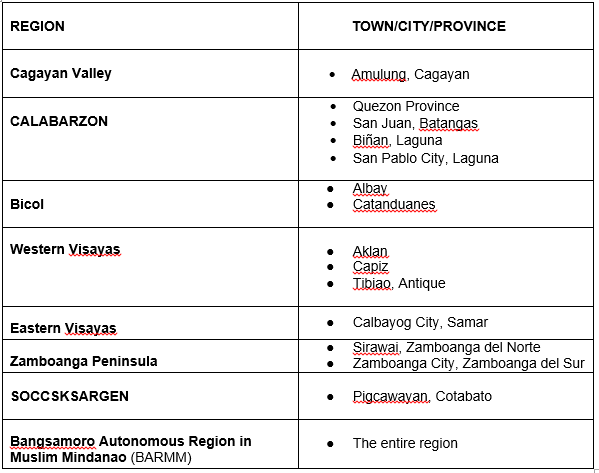
On October 29, the NDRRMC proposed to the president to put the whole country under a state of calamity. However, it was rejected by the president as heavy damage was limited to some areas. The destruction was highly localized, and this was particular to the provinces of CALABARZON, Visayas, and Maguindanao.
Two days after the onslaught of STY Paeng, several areas remain submerged in knee-deep floodwaters including some towns in Cavite and Batangas. Many residents in Brgy. Poblacion in Cavite are pleading for help as assistance has yet to arrive. According to the residents, they never experienced a flood of this magnitude; that’s why they weren’t able to save most of their things. Aside from financial assistance, they are also seeking clothes, food, and livelihood assistance to help them recover from this disaster. In Brgy. Catmon, Batangas, many families were also greatly affected by the recent storm. Houses and boats were destroyed during the onslaught of STY Paeng.
Agriculture
Meanwhile, thousands of farmers and fishermen are reeling from further losses due to STY Paeng. According to the Department of Agriculture, Paeng’s damage to agriculture reached P1.3 billion, which is likely to cause a rise in inflation. Damage and losses were reported in the Cordillera Administrative Region, Central Luzon, Calabarzon, Mimaropa, Bicol, Western Visayas, Zamboanga Peninsula, and Soccsksargen, affecting 53,849 farmers and fishermen, with production losses amounting to 66,963 metric tons and 64,607 hectares of agriculture areas.
Infrastructures
Based on the latest report released by the National Disaster Risk Reduction and Management Council (NDRRMC), damage to infrastructures incurred was estimated at nearly P900 million. Bicol, one of the severely hit regions by Paeng, may have the least damage in infrastructure, which included a bridge and a few government facilities in Caramoan, but it was the highest in terms of cost at P375,179,500. A total of P1.475 million-worth of National Irrigation Administration infrastructure was also damaged in Bicol. Next is Central Visayas which incurred P277 million-worth of damages, followed by Northern Mindanao pegged at P110.05 million.
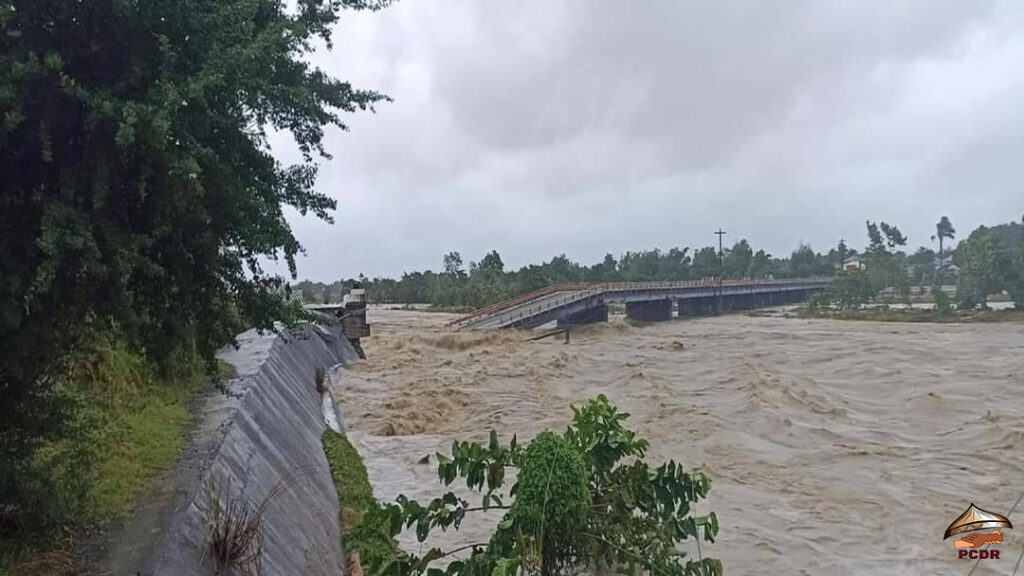
The NDRRMC also recorded more than 120 landslides in different parts of the country. The storm left at least 121 casualties.
Source: National Disaster Risk Reduction and Management Council, PAGASA, Inquirer, Bangsamoro Autonomous Region in Muslim Mindanao (BARMM) (Readi), Inquirer, Rappler, Department of Agriculture.
Affected Populations
The affected population for the whole BARMM is pegged at 570,285 individuals of which 22,115 individuals or 4,370 families are staying in 70 evacuation centers. As the flood recedes, the majority of the evacuees have returned to their homes except for those whose houses have been completely destroyed.
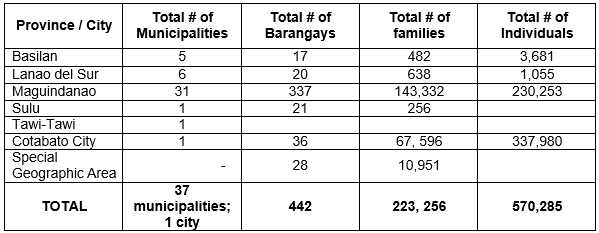
Casualties
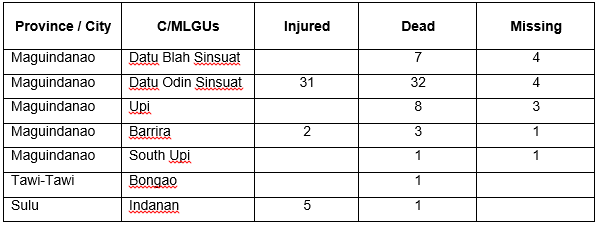
According to the rapid damage and needs assessment conducted by our partner in the National Capital Region, the Community Response for Enlightenment, Service, and Transformation, Inc. (CREST), approximately 1,300 families are displaced in Brgy. Baseco Compound and Marikina City. These evacuees are temporarily seeking shelter in evacuation centers — mostly in school buildings, barangay offices, and churches.
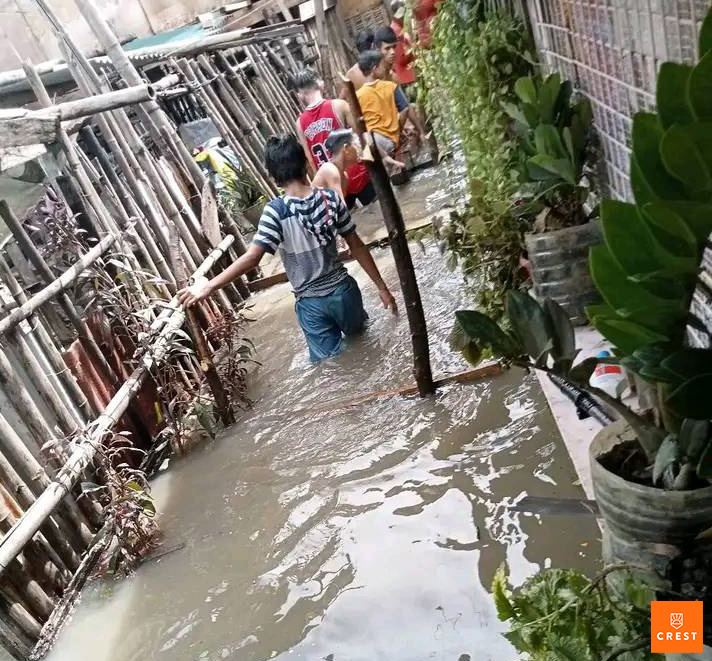
Meanwhile, based on the NDRRMC’s situation report no. 11 as of Wednesday morning, November 2, the fatalities due to Paeng have climbed to 121, from 112 on Tuesday evening. The agency’s latest situation report indicated that 92 deaths were confirmed, while 29 are subject to validation. While almost half of the confirmed casualties are from BARMM, almost a quarter were from Western Visayas. A total of 103 people incurred injuries, while authorities continued searching for 36 missing individuals.
The latest figures indicate that a total of 927,822 families or 3,180,132 persons were affected in 7,341 barangays in Regions NCR,1, 2, CALABARZON, MIMAROPA, 5, 6, 7, 8, 9 10, 11, 12 and CAR, while a total of 347,485 individuals have been displaced and have sought temporary shelters in schools, barangay halls, and other evacuation centers. Electricity has been cut down, particularly in most provinces of the Bicol Region, CALABARZON, and BARMM region as electricity poles have also been damaged. Waterworks and communication signals have been damaged by the typhoon as well. Power interruptions were experienced in 297 various municipalities directly affected by the storm and 50% of it was already restored. There is water outage in 17 municipalities, while progress continues in restoring electricity and communication services, according to the Department of Electricity (DOE). STY Paeng also left 2,104 totally damaged houses and 9,190 received partial damage.
Source: Bangsamoro Autonomous Region in Muslim Mindanao (BARMM) (Readi), CREST, Rappler, Inquirer
Emergency Response Efforts
1. CDRC is closely monitoring STS Paeng since it was spotted by PAGASA. It is also monitoring the situation in the affected areas and constantly updating its situation reports.
2. CDRC is closely coordinating with its regional partners in affected areas to collect information on the situation and needs on the ground.
3. On October 28, CDRC activated its Emergency Response Team for STS Paeng, ready for deployment within the affected areas in anticipation of any eventualities brought about by the storm.
4. CDRC’s Regional Partners have started coordinating with their respective LGU partners, particularly with the Local DRRM Offices in the affected cities and provinces.
5. Emergency Response Teams of the respective affected regional partners have been monitoring developments in the local situation and continue to send data from the ground.
6. Our regional partner, Tarabang sa Bicol has povided hot meals to several evacuation centers in Brgy. Mauraro in Guinobatan Albay as their first response effort.
7. CDRC is now coordinating with different agencies and organizations to raise funds and donations for the affected communities. In addition to coordinating between partners and other networks, typhoon-affected regional partners are currently sending appeals for the Emergency Relief Assistance Fund.
8. With the rising need for emergency response, CDRC coordinates mechanisms and fundraising efforts. A call for donations for STY Paeng has already been posted on our official Facebook Page.
9. CDRC has activated its emergency relief assistance funds to provide support to the affected communities through direct food assistance.
Resources Available
1. Standby emergency funds
2. Prepositioned goods at the CDRC warehouse
3. Monetary and in-kind donations
Expressed Needs
Access to emergency food packs is considered one of the primary needs in the most affected regions. The other most pressing needs include WASH, medicines, sleeping materials, and sanitation kits. Livelihood support for affected farmers and fishermen is also a major concern.
Coordination
Regional Partners
1. Tarabang sa Bicol, Inc. (TABI)
2. Southern Tagalog People’s Response Center, Inc. (STPRC)
3. Panay Center for Disaster Response, Inc. (PCDR)
4. Leyte Center for Development, Inc. (LCDe)
5. Community Response for Enlightenment, Service, and Transformation, Inc. (CREST)
6. Lambak Cagayan Mission Center, Inc. (LCMCI)
7. Disaster Response Center, Inc. (DIRECT)
8. Mindanao Interfaith Services Foundation, Inc. (MISFI)
Contacts
1. Cora Jazmines, Local Partnerships Department, 0928-182-4969, lpd@cdrc-phil.com
2. Dom Ybera, Deputy Executive Director, dybera@gmail.com
